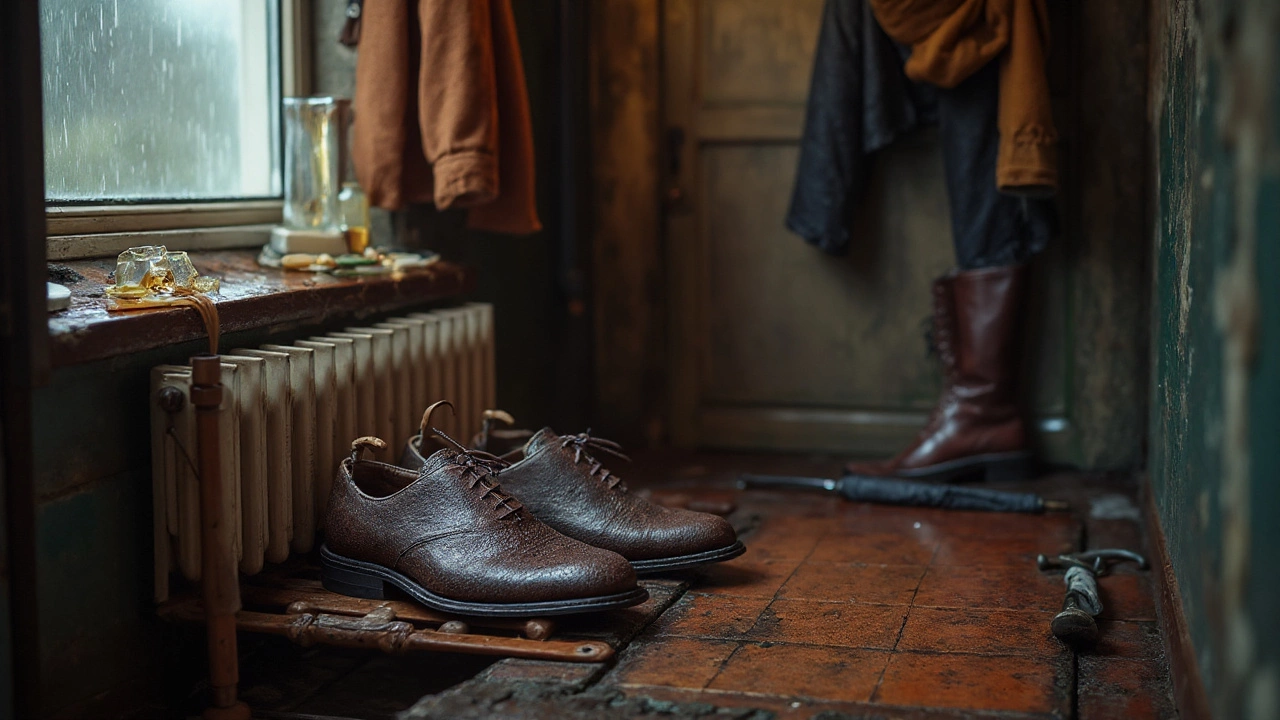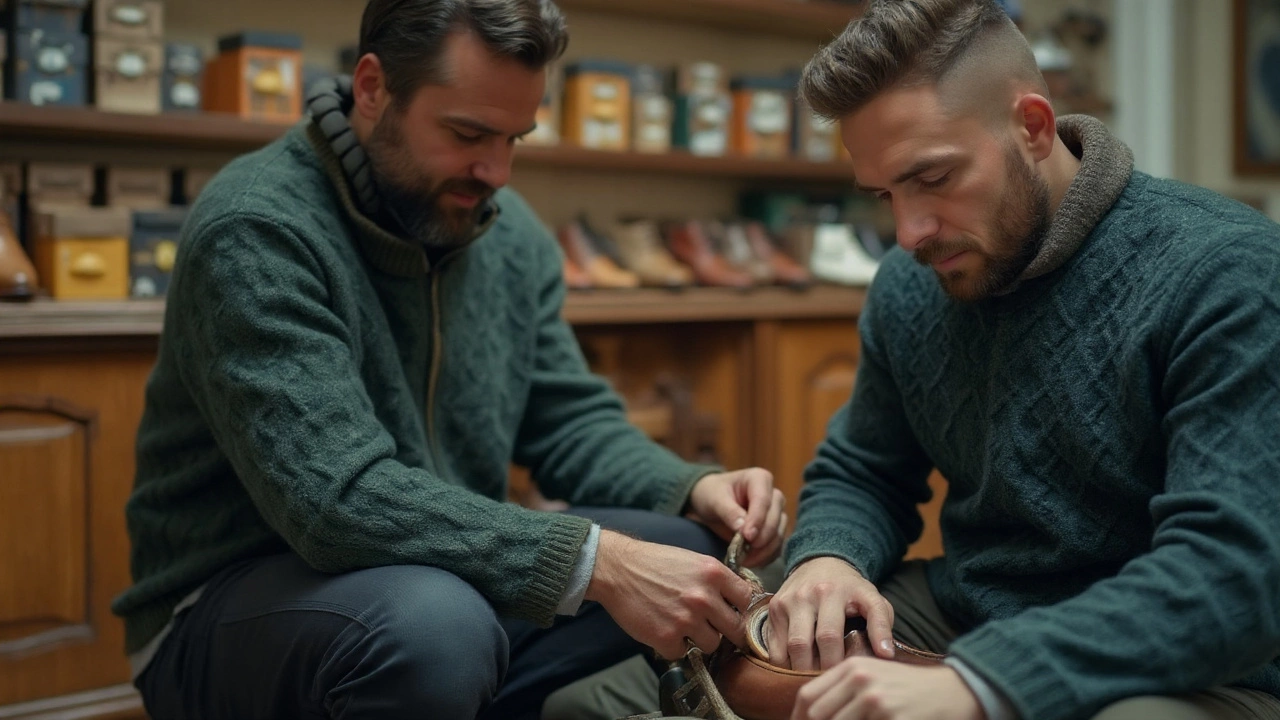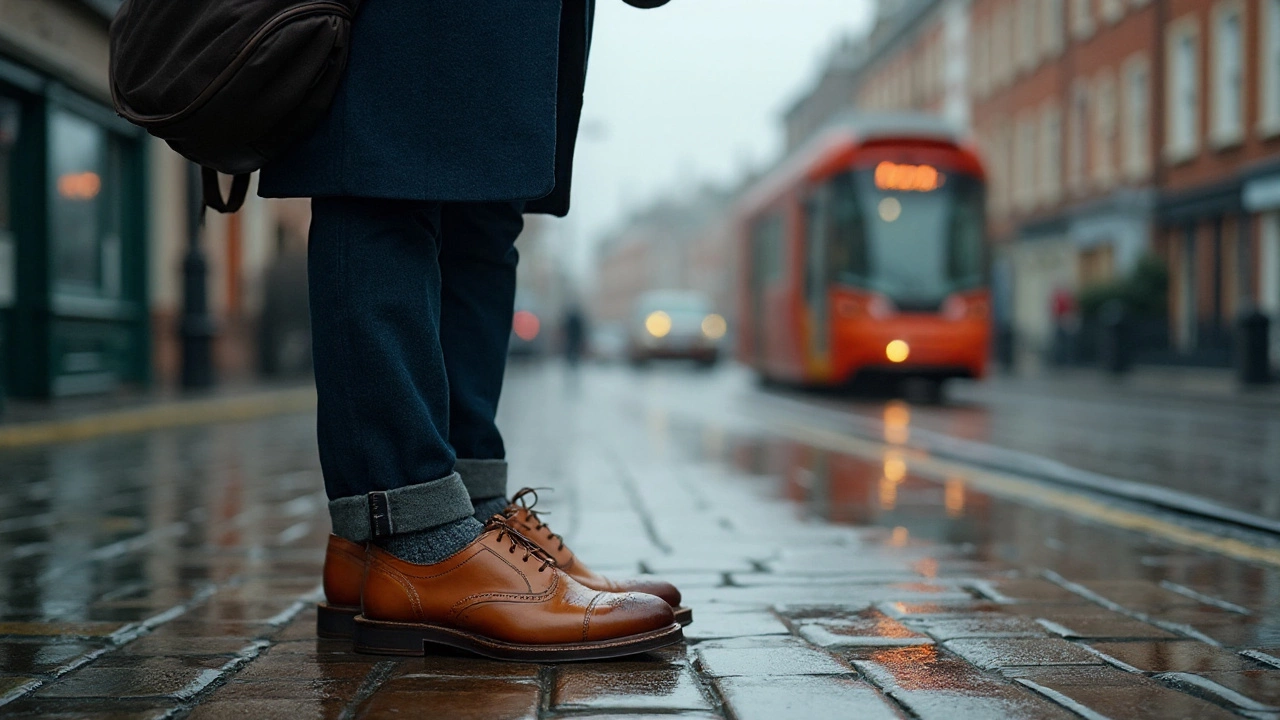New leather shoes look the part, but that first week can feel like toe-wrestling. If you live in Ireland, add wet pavements, cobbles, and long commutes, and the question gets real fast: how long until they stop biting and start behaving?
If you’re searching ‘break in leather shoes Ireland’, here’s the blunt truth: most pairs settle in within 5-30 hours of wear across several short outings. Softer leathers are quicker; Goodyear-welted dress shoes and dense hides take longer. Rain slows you down and can damage leather if you push it. The right plan gets you there without blisters or wrecking a €250 pair from Grafton Street.
- Typical timelines: soft calf/suede 5-10 hours (3-5 short wears); Goodyear-welted brogues/oxfords 15-30 hours (6-12 wears); boots/shell cordovan 20-50 hours.
- Wear plan: start with 45-90 minutes indoors or on smooth paths, rest 24 hours with cedar trees after each wear, increase time gradually.
- Irish weather rule: never soak; if they get wet, air-dry away from heat and use trees. Consider a thin rubber half-sole before your first rainy commute.
- Speed-ups: professional stretching in Dublin/Cork/Galway (€10-€20 in 2025) for tight spots. Skip heaters and wet-sock hacks.
- Fit check: slight heel slip (3-5 mm) is normal early; toe box should allow wiggle. Persistent pinch across the toes or numbness means wrong size or last-swap early while you can.
How long it actually takes (by leather, construction, and Irish use)
Break-in time isn’t random. It’s about leather density, lining, construction, and how you use them day to day in Ireland-wet mornings, long walks to the LUAS, slick granite footpaths, and the odd sprint for a bus.
Quick benchmarks for Ireland:
- Suede or soft calf (Blake-stitched or cemented): 5-10 hours across 3-5 wears. Great for city office wear and occasional showers (with spray protection).
- Goodyear-welted dress shoes (Loake, Barker, Grenson commonly sold at Arnotts/Brown Thomas): 15-30 hours across 6-12 wears. The cork footbed needs time to mould.
- Country/pebble-grain leather and classic brogues: 15-35 hours. Stiffer uppers but very durable for Irish weather with care.
- Boots with thicker veg-tan leather: 20-40 hours. Daily short walks help; first hill walk in Wicklow can wait.
- Shell cordovan: 20-50 hours. Dense fibres, minimal stretch; excellent once dialled in, but you need patience.
- Patent leather: 10-20 hours; the overlay doesn’t stretch much, so fit must be right from day one.
New leather soles are slippery on wet pavements-very Irish problem. Scuff them lightly on carpeted stairs at home or fit a thin rubber half-sole at a cobbler before your first rainy dash down Nassau Street. Your future self will thank you.
| Leather / Build | Typical break-in (hours) | Feels right after | Irish notes / examples |
|---|---|---|---|
| Suede or soft calf (Blake/cemented) | 5-10 | 3-5 short wears | Great for office in Dublin/Cork. Protect with a water-repellent spray before first wear. |
| Goodyear-welted calf (dress shoes) | 15-30 | 6-12 wears | Common brands in Ireland: Loake, Barker, Grenson. Consider a rubber half-sole. |
| Pebble-grain / country leather | 15-35 | 7-12 wears | Stiffer uppers; good for Irish drizzle with cream polish and occasional conditioner. |
| Leather boots (veg-tan uppers) | 20-40 | 8-14 wears | Short daily walks, not all-day hikes at first. Dry thoroughly if wet. |
| Shell cordovan | 20-50 | 10-20 wears | Minimal stretch; fit must be spot-on. Avoid heavy rain early on. |
| Patent leather | 10-20 | 4-8 wears | Little give; watch for toe pinch. Good for events, not long commutes. |
Why the range? Dense leathers resist flex, Goodyear welts have a cork layer that beds in, and linings add structure. The Royal College of Podiatry notes feet are slightly larger later in the day, and that matters-an evening try-on often prevents a too-snug fit that feels fine in the morning but bites by 5 pm. SATRA, the UK footwear research body, has long shown that leather flexes more freely after initial cycles, which matches the lived experience: the first few hours feel stiff, then things ease quickly.
A quick Irish reality check: wet leather stretches unpredictably and can stain or ripple. Don’t use rain as a break-in tool. If you get caught in a shower (which you will), it’s fixable-just dry them right (details below).

The break-in plan that works on Irish streets (step-by-step)
This is the plan I use here in Dublin-good for city commutes, office days, and weekend strolls. It balances comfort, speed, and the weather we deal with.
Before your first wear
- Fit check in the afternoon. Feet swell a bit by day’s end. You want snug across the midfoot, toe wiggle (a few millimetres), and only slight heel slip. If your toes graze the front when walking, change size or last immediately.
- Prep the leather. For calf and grain leather, apply a thin layer of neutral or matching cream polish. For suede, use a water-repellent spray. Skip heavy oil-too much can soften and deform the fit.
- Protect the sole if needed. If the outsole is smooth leather and you’ll be on wet pavements, consider a thin rubber half-sole from a cobbler (MISTER MINIT and many independents nationwide do this). It doesn’t ruin the look and saves you from skating across Stephens Green.
Week 1: gentle starts
- Day 1: 45-90 minutes indoors or on dry paths. Use a thin merino dress sock. Lace firmly through the instep; keep the forefoot comfortable.
- Day 2: 90-120 minutes. Light errands, a short LUAS hop, no long hills. If a hot-spot shows up, mark it mentally.
- Rest 24 hours with cedar trees. Trees pull moisture and help the upper reset to your foot shape. No trees? Stuff with dry paper, then add trees once mostly dry.
- Day 3-5: 2-3 hours each day. Add normal walking but avoid long rainy stretches. If Dublin does its thing, carry a backup pair in your tote.
- Day 6-10: half days, then full days. If they feel 80% comfy, try a full office day with a desk backup. If not, repeat short wears.
Hot-spot fixes (use sparingly)
- Heel rub: Use a “heel lock” lacing (runner’s loop) to anchor your heel. A thin heel grip can help; avoid thick foam that changes fit.
- Toe pinch: Use a shoe stretcher with a spot plug overnight, or ask a cobbler to punch the toe box a touch. Don’t hammer the leather at home.
- Instep pressure: Skip the top eyelet for a week, or switch to a slightly longer lace to relieve the throat.
- Blisters: Pre-tape with hydrocolloid (Compeed is everywhere in Irish pharmacies). A dab of petroleum jelly on known rub points works for a short wear.
If they get wet (very Irish)
- Wipe off grit, remove laces and insoles.
- Stuff with paper for 30-60 minutes to wick initial moisture.
- Air-dry at room temp, away from radiators or fireplaces. Heat hardens leather and makes creases crack.
- Add cedar trees once surface-dry. Next day, condition lightly if the leather looks thirsty.
Two short, real-world examples
- Goodyear-welted brogues from a Dublin department store: 20 hours to fully comfy. Three short wears at home, two 2-hour office visits, then a full day with no rub. Rubber half-sole fitted on day two-zero slipping in rain.
- Dubarry deck shoes for weekends in Howth: Soft nubuck, broke in within 6 hours over two afternoons. Needed only a water-repellent spray and a light brush after sea mist.
Quick checklists
- Break-in kit: cedar shoe trees, cream polish or suede spray, thin merino socks, blister plasters, spare laces, soft cloth, small shoehorn.
- Before you leave the shop: try both shoes in the afternoon, walk a loop on carpet, check toe wiggle, confirm return policy, snap a pic of the size/last code for future reference.

Shortcuts, mistakes, and what to do if they still hurt
Safe shortcuts (that actually work in Ireland)
- Professional stretch: A cobbler can stretch width or targeted spots. Typical 2025 Irish prices: €10-€20 for spot work, €20-€35 for full width. Ask for a minimal first pass-you can always add more.
- Shoe stretcher + spray at home: Use a wooden stretcher with a water‑alcohol spray made for leather. One night, then test. Don’t overdo; leather remembers.
- Warmth, not heat: Body warmth works. Wear for an hour at home with movement. Avoid hairdryers and radiators-those can cook finishes and stiffen fibers.
- Insole tuning: A thin leather insole can snug volume if your heel slips. Try it after a few wears, not day one.
Common mistakes to avoid
- All-day first wear: A 9-to-5 on brand-new Goodyear-welted shoes is how you get heel blisters and hate the shoes by lunch.
- Water tricks: Wet socks, soaking, or rain “on purpose” can warp leather, pop stitches, and stain lining.
- Heavy oils or conditioners early: They soften structure and can stretch the shoe the wrong way. Use light cream polish.
- Heat drying: Radiators and fires are part of Irish life; they’re leather’s enemy. Air-dry only.
- Ignoring return windows: If the last doesn’t suit your foot, no amount of suffering fixes it. Swap while you can-most Irish retailers are decent about unworn returns.
When to return, stretch, or size up/down (simple decision guide)
- Pain across the widest part of the forefoot (toe box): If it’s strong after 3-4 short wears, request a professional toe punch or width stretch. If nails feel pressure or toes numb, exchange for a wider last.
- Heel slip > 5 mm after 5 wears: Try a heel lock lacing and a thin insole. If still loose, size down or pick a last with a tighter heel cup.
- Instep bite (lace area): Loosen top eyelets and try a slightly longer lace. Persistent pressure? Different last or half-size up.
- Arch fatigue: Add a low-profile support insole after break-in starts. If pain continues, see a podiatrist; APMA and the Royal College of Podiatry both recommend addressing persistent foot pain early.
Mini‑FAQ
- Can I break them in faster by wearing thick hiking socks? For 30-60 minutes at home, fine. All day? You’ll stretch the collar and alter fit. Better to do more short sessions with normal socks.
- Do leather soles get ruined by Irish rain? Not if you dry them right and rotate pairs. If your commute is always wet, add a thin rubber half-sole.
- How do I stop squeaking? Lightly condition the tongue and lace eyelets; a bit of talc under the insole can help. Squeaks usually fade as the layers bed in.
- Should I condition brand-new shoes? A small amount of cream polish on calf/grain is good. Skip heavy conditioners early.
- How much heel slip is OK? Up to 3-5 mm when new is fine, especially with Goodyear-welted shoes. It should reduce as the cork molds and the heel counter softens.
Local tips from the Irish shoe bench
- Shop smart: Brown Thomas, Arnotts, and good independents from Galway to Belfast carry UK/EU sizes; ask about last shapes (e.g., Loake 026 vs Capital lasts feel different).
- Weatherproofing: Irish drizzle is relentless. A light cream and wax combo every few weeks, plus a suede spray, keeps you ahead of it.
- Rotation: Two pairs for the office is ideal. Wear A on Monday/Wednesday, B on Tuesday/Thursday. Feet and leather both get rest days.
- Country use: For boggy weekends in Mayo, go boots, not dress shoes. Let the right pair do the right job.
Troubleshooting by persona
- Office commuter (Dublin/Cork): Add a rubber half-sole before week one, carry a backup sneaker on wet days, and stick to 1-2 hour break-ins.
- Event-goer (weddings/grad balls): Do three 60-90 minute wears at home the week before. Bring foldable plasters and a spare set of thin socks on the day.
- Student on a budget: Choose softer leathers or suede to minimise break-in time. Use cedar blocks or paper if trees are pricey; upgrade later.
- Rural/weekend walker: Don’t debut leather soles on soaked lanes. Start on dry paths; switch to rubber-soled boots if the forecast looks grim.
If you do the short sessions, rest with cedar trees, and listen to hot-spots, most pairs feel yours within a fortnight. And if a shoe just isn’t your shape, that’s not failure-it’s a last mismatch. Swap early, and your feet will be grand. I live in Dublin and learned this the hard way on a wet November morning sprinting for the 46A-don’t be me, plan the break-in.
